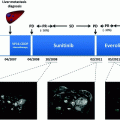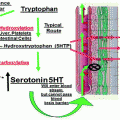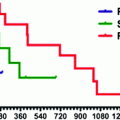Fig. 7.1
45-year-old man with small bowel neuroendocrine tumor, with left hepatectomy for liver metastasis. a Axial CT scan (arterial phase) shows new metastatic liver lesion in the remnant right liver. b Axial CT scan (portal venous phase) obtained after RFA of the lesion shows hypoattenuation with no residual lesion
Classical indications of RFA are LM fewer than five lesions and tumor size less than 5 cm [2]. Yet, two other issues should be discussed in LM from NET: the role of RFA in tumor debulking and in controlling functional syndromes due to specific hormones excess. This explains that most series of patients with LM from NET had more than 5 ablated tumors with intra-operative RFA during one session [13, 14].
In Elias’s series, 16 patients had combined liver surgery and RFA [13]. A mean of 15 and 12 LM per patient were surgically removed and RF ablated, respectively. Morbidity was observed in 69 % of the cases. The 3-year overall survival and disease-free survival were similar to their previous experience of liver resection alone of LM from NET.
In Akyildiz’s series, 119 laparoscopic RFAs without liver resection were performed in 89 patients with LM from NET. The mean tumor size was 3.6 cm and the mean number of tumors was 6 (range 1–16) [14]. Perioperative morbidity was 6 % and 30-day morbidity was 1 %. Fourty four patients had hormonal symptoms prior to the procedure. One week after RFA, 97 % of these patients reported at least partial symptoms relief, and 73 % had significant or complete relief. The symptomatic response lasted for a median of 14 ± 5 months [14]. Median disease-free survival was 1.3 year and overall survival was 6 years after RFA.
One of the major problems is the recurrence of metastases within the liver as new tumors are reported up to 63 % in the largest series of patients treated with RFA [14]. Conversely, local liver recurrence was observed from 3.3–7.9 % per lesion [14, 15]. Interestingly, in a meta-analysis including 5.224 ablated tumors of various origins, the rate of local recurrence was lower in neuroendocrine LM than in others [15]. This might be due to tumor characteristics such as well-circumscribed margins or to natural history of these tumors [15].
As in other liver malignancies, factors predictive of tumor recurrence are tumor size, ablation margin, and blood vessel proximity [16]. In a multivariate analysis, statistically significant determinants of survival were only gender (with males having the worse prognosis) and size of the dominant liver metastasis (a tumor size exceeding 3 cm was associated with a greater mortality) [17].
Complications observed after RFA are not related to tumor type. They include pain, bile leakage, liver abscess, intra-abdominal hemorrhage, bowel perforation and pulmonary complications [2, 14, 16, 17].
In some patients, RFA is considered in patients with LM who had previous Whipple procedure and bilioenteric anastomosis. We have to keep in mind that there is an increased risk of liver abscess formation in those patients (40 vs. 0.4 %) [16].
In summary, RFA of LM from NETs differs from other LM due to the large number of lesions per patient. Then, RFA is mostly palliative aiming at debulking and controlling hormonal symptoms. This explains why intra-operative approach with or without combined liver resection is preferred rather than percutaneous approach.
Microwave Ablation
MWA uses electromagnetic devices with frequencies ≥900 MHz. The principle of this technique is similar to RFA but has several theoretical advantages. First, the intra-tumoral temperatures are consistently higher than can be achieved with RFA. Second, MWA is overcoming the “heat sink” effect observed in RFA due to the cooling effect of blood flow in large vessels close to the tumor, both resulting in a better tumor control.
MWA has not been extensively evaluated in LM from NET. Only one series reported 11 patients with LM from NET out of 100 patients [18]. As with RFA, most procedures were performed intra-operatively either with concomitant hepatic resection (7/11) or with concomitant extrahepatic tumor resection (6/11). The median number of ablated LM was 4 ranging from 1–13 tumors. Complications were observed in 3 patients. No local liver recurrence was noticed [18].
Cryotherapy
Cryotherapy is based on the decreased cell viability at low temperatures. The obtained tissue temperature should be −50 °C to achieve necrosis in neoplastic tissue.
To our knowledge, only three series have evaluated cryotherapy in LM from NETs (the largest with 19 patients) [19–21]. As with other thermal ablative techniques, hormonal symptoms relief was observed in the vast majority of patients. Notably, post-procedural coagulopathy has been found in all patients of the two main series [20, 21] requiring transfusion of either platelets or fresh frozen plasma. In one of these series, 2 patients required intra-abdominal packing and transfusion of clotting factors [21]. The authors have not observed similar complications in any other liver malignancies and speculated that the necrosing carcinoid tumors were releasing substances that may disrupt the coagulation cascade [21].
Despite the efficacy on hormonal symptoms, cryotherapy has been gradually replaced by RFA, mainly for safety reasons.
Radioembolization
Radioembolization is defined as the injection of micron-sized embolic particles loaded with radioisotope by use of percutaneous transarterial techniques. Radioembolization with Yttrium-90 microspheres involves infusion of embolic microparticles of glass or resin impregnated with the isotope Yttrium-90 through a catheter directly into the hepatic arteries. Yttrium-90 is a pure β emitter and decays to stable Zr-90 with a physical half-life of 64.1 h. The average energy of the β particles is 0.9367 MeV, has a mean tissue penetration of 2.5 mm, and has a maximum penetration of 10 mm.
The efficacy of this radioembolization technique is based on the fact that intra-hepatic malignancies derive their blood supply almost entirely from the hepatic artery, as opposed to the normal liver, which mainly depends on the portal vein. The microspheres are injected selectively into the proper hepatic artery and subsequently become lodged in the microvasculature surrounding the tumor. Very high irradiation doses are delivered to the tumors, whereas the surrounding liver parenchyma is largely spared.
The use of Yttrium-90 for the treatment for primary and secondary liver malignancies is no longer investigational or experimental and both devices have got FDA and European approval.
The technique comprises two steps:
The first step is patient eligibility and conditioning. Selective mesenteric and hepatic angiography and scintigraphy are performed for several reasons:
to document the visceral anatomy and identify hepatic arterial anatomic variants,
to isolate the hepatic circulation by occluding extrahepatic vessels with prophylactic embolization of extrahepatic arteries (e.g., right gastric, gastroduodenal artery),
to evaluate the hepatic arterial supply of the tumors, and
to calculate the lung shunting.
The second step is the radioembolization therapy itself. Several days after patient eligibility and conditioning, treatment is performed with microsphere infusion proceeding at flow rates similar to that of the native hepatic artery. Treatment for the contralateral lobe, if needed, is usually performed 30–60 days.
The largest series of selective interval radiation therapy (SIRT) of LM from NET is a retrospective review of 148 patients from 10 institutions. Complete and partial tumor responses were seen in 2.7 and 60.5 % of the cases according to RECIST criteria, respectively [22]. Stable disease was observed in 22.7 % of the cases and progressive disease occurred in only 4.9 % of the cases [22]. Similar results were reported in the other series including a prospective one [23–28] Paprottka et al. have observed that 97.5 % of LM become necrotic or hypovascular explaining the high rate of overall response when using imaging criteria which aim to depict tumor changes such as EASL or mRECIST criteria.
Low toxicity is another advantage of radioembolization. Side effects are mainly represented by fatigue, nausea or vomiting, and abdominal pain; No Grade 4 toxicities but one were seen in articles which detail complications [22, 28, 30] after the procedure. Moreover, no radiation-induced liver failure was described in those patients [22, 28, 30].
Transarterial Chemoembolization and Bland Embolization
Rationale and Results
The rationale for transarterial hepatic embolization (TAE) is based on the fact that most LM from NET are hypervascular and derive their blood supply from hepatic artery. The goal of TAE is to induce ischemia of tumor cells thereby reducing hormone output and causing necrosis. Various particles have been used including gelfoam, polyvinyl alcohol particles, and more recently microspheres.
In the 1990s, transarterial chemoembolization (TACE) has been developed based on the principle that ischemia of the tumor cells increases sensitivity to chemotherapeutic substances [31]. Another advantage of TACE over TAE is the higher drug concentration obtained by regional delivery of chemotherapy. Various drugs have been used: doxorubicin and streptozotocin being the most common injected and, alone or in combination, mitomycin C, cisplatin, and gemcitabine. Even some teams have injected a mixture of doxorubicin, mitomycin, and cisplatin. In TACE, embolization is performed immediately after intra-arterial injection of cytotoxic agents. As injection of streptozotocin has been reported to be painful, the procedure is then performed under general anesthesia [32].
More recently, three trials have evaluated drug-eluting beads with doxorubicin in LM from NETs. Drug-eluting beads are particles which are preloaded with any chemotherapeutic agent. The principle is to deliver high dose and more sustained release of drug into the tumor compared to systemic chemotherapy [33, 34].
Despite the large number of TACE or TAE studies performed in patients with LM from NET, there are no randomized trials. Table 7.1 summarizes the main results of these treatments. Most of these studies have evaluated clinical, biological, and morphological responses. Partial or complete symptoms’ relief was observed in 42–100 % (Table 7.1) which lasts between 9 and 24 months [35, 36]. Significant decrease in tumor markers occurred in 13–100 % [35, 37]. Morphological response (either complete or partial) was seen in 8–94 % [37, 38]. Yet, imaging criteria for assessing tumor response have not been detailed in all published articles. When evaluated, overall survival since TAE or TACE initiation ranges from 15–80 months [39, 40].
Table 7.1
Results of TACE or TAE studies performed in patients with LM from NET
Author | Years | Patients/session | Tumor | Treatment | Methods | PR | SD | PD | TTP | OS | Symptom relief (%) | Bioch resp (%) |
|---|---|---|---|---|---|---|---|---|---|---|---|---|
Carrasco [37] | 86 | 25/79 | 16 SB | TAE | Sponge | 94 | 11 | 16 | 87 | 100 | ||
9 other | ||||||||||||
Ajani [65] | 88 | 22/97 | GP | TAE | PVA | 60 | 34 | 60 | 60 | |||
Ruszniewski [54] | 93 | 23/71 | 18 SB | TACE | Doxo+sponge | 61 | 22 | 17 | 14 | 73 | 57 | |
5 GP | 20 | 40 | 40 | 12 | ||||||||
Therasse [36] | 93 | 28 | SB | TACE | Doxo+sponge | 35 | 24 | 29 | 24 | 100 | 91 | |
Diamandidou [66] | 98 | 20/60 | 17 SB | TACE | Microencapsulate cisplatine | 78 | 22 | 67 | 73 | |||
3 GP | ||||||||||||
Eriksson [40] | 98 | 41/55 | 29 SB | TAE | Sponge | 38 | 43 | 19 | 12 | 80 | 52 | 38 |
12 GP | 17 | 8 | 16 | 10 | 20 | 50 | 42 | |||||
Brown [52] | 99 | 35/63 | 21 SB 14 GP | TAE | PVA | 15 | 21 | 89 | ||||
Kim [39] | 99 | 30 | 16 SB | TACE | Cispl+doxo | 25 | 24 | 15 | 75 | |||
5FU+STZ | ||||||||||||
14 GP | 50 | 90 | ||||||||||
Dominguez [32] | 00 | 15/45 | 8 SB | TACE | STZ | 53 | 11 | 60 | 50 | |||
7 GP | ||||||||||||
Gupta [67] | 03 | 81 | SB | TAE 50 | PVA or sponge | 75 | 16 | 9 | 19 | 31 | 63 | |
TACE 31 | ||||||||||||
No precision | ||||||||||||
Kress [38] | 03 | 26/62 | 12 SB | TACE | No precision | 8 | 53 | 19 | ||||
10 GP | ||||||||||||
4 UK | ||||||||||||
Loewe [68] | 03 | 33/75 | SB | TAE | Cyanoacrylate | 73 | 23 | 4 | 56 | 62 | ||
Roche [51] | 03 | 14 | SB | TACE | Doxo+sponge | 72 | 14 | 14 | 47 | 90 | 75 | |
Roche [50] | 04 | 64/186 | TACE | Doxo+sponge | 74 | 15 | 93 | 52 | ||||
Gupta [44] | 05 | 123 | 69 SB | 42TAE+27TACE | PVA or sponge | 67 | 23 | 34 | ||||
No precision | ||||||||||||
32TAE+22TACE | ||||||||||||
54 GP | 35 | 16 | 23 | |||||||||
Osborne [69] | 06 | 59 | 42 SB | TAE | PVA or embosphères | 22 | 24 | 81 | ||||
17 GP | ||||||||||||
Strosberg [46] | 06 | 84 | 59 SB | TAE | PVA or embosphères | 48 | 52 | 0 | 36 | 80 | 91 | |
20 GP | ||||||||||||
5 other | ||||||||||||
Bloomston [70] | 07 | 122 | SB | TACE | Doxo+mito+cispl | 82 | 12 | 19 | 33 | 92 | 80 | |
Sp, PVA or emb | ||||||||||||
Granberg [35] | 07 | 15/23 | 7 SB | TAE | Embosphères | 35 | 56 | 9 | 6 | 42 | 13 | |
8 other | ||||||||||||
Ho [45] | 07 | 46/93 | 31 SB | TAE 7 | Sponge ou PVA | 45 | 32 | 23 | 42 | 42 | 78 | |
TACE 86 | ||||||||||||
Doxo+mito+cispl | ||||||||||||
15 GP | 45 | 45 | 9 | |||||||||
Marrache [12] | 07 | 67/163 | 48 SB | TACE | STZ(44) ou doxo(23) | 37 | 36 | 27 | 15 | 91 | 65 | |
19 GP | ||||||||||||
Ruutiainen [43] | 07 | 67/219 | TAE 23 | PVA | 15 | |||||||
TACE 44 | ||||||||||||
Doxo+mito+cispl | 7 | |||||||||||
De Baere [33] | 08 | 20/34 | TACE | Deb Doxo | 80 | 15 | 5 | 15 | ||||
Kamat [71] | 08 | 38 | 7 SB | TAE ou TACE
Stay updated, free articles. Join our Telegram channel
Full access? Get Clinical Tree
 Get Clinical Tree app for offline access
Get Clinical Tree app for offline access

|



